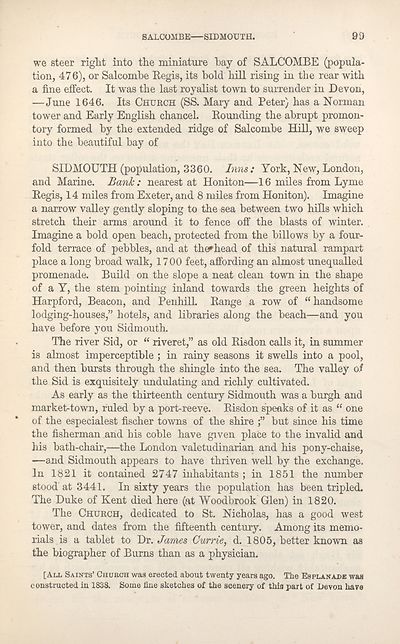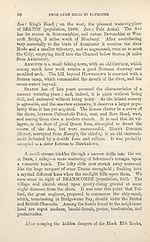Download files
Complete book:
Individual page:
Thumbnail gallery: Grid view | List view

SALCOMBE SIDMOTJTH.
we steer right into the miniature hay of SALCOMBE (popula¬
tion, 476), or Salcomhe Begis, its hold hill rising in the rear with
a fine effect. It was the last royalist town to surrender in Devon,
—June 1646. Its Church (SS. Mary and Peter) has a Norman
tower and Early English chanceh Bounding the abrupt promon¬
tory formed hy the extended ridge of Salcomhe Hill, we sweep
into the beautiful bay of
SID MOUTH (population, 3360. Inns: York, New, London,
and Marine. Bank : nearest at Honiton—16 miles from Lyme
Begis, 14 miles from Exeter, and 8 miles from Honiton). Imagine
a narrow valley gently sloping to the sea between two hills which
stretch their arms around it to fence off the blasts of winter.
Imagine a bold open beach, protected from the billows by a four¬
fold terrace of pebbles, and at the»head of this natural rampart
place a long broad walk, 1700 feet, affording an almost unequalled
promenade. Build on the slope a neat clean town in the shape
of a Y, the stem pointing inland towards the green heights of
Harpford, Beacon, and PenhilL Bange a row of “handsome
lodging-houses,” hotels, and libraries along the beach—and you
have before you Sidmouth.
The river Sid, or “ riveret,” as old Bisdon calls it, in summer
is almost imperceptible ; in rainy seasons it swells into a pool,
and then bursts through the shingle into the sea. The vaHey of
the Sid is exquisitely undulating and richly cultivated.
As early as the thirteenth century Sidmouth was a hurgh and
market-town, ruled by a port-reeve. Bisdon speaks of it as “ one
of the especialest fischer towns of the shire but since his time
the fisherman and his coble have given place to the invalid and
his bath-chair,—the London valetudinarian and his pony-chaise,
—and Sidmouth appears to have thriven well by the exchange.
In 1821 it contained 2747 inhabitants ; in 1851 the number
stood at 3441. In sixty years the population has been tripled.
The Duke of Kent died here (at Woodbrook Glen) in 1820.
The Church, dedicated to St. Nicholas, has a good west
tower, and dates from the fifteenth century. Among its memo¬
rials is a tablet to Dr. James Cwrrie, d. 1805, better known as
the biographer of Burns than as a physician.
[All Saints’ Chuboh was erected about twenty years ago. The Esplanade was
constructed in 1838. Some fine sketches of the scenery of this part of Devon have
we steer right into the miniature hay of SALCOMBE (popula¬
tion, 476), or Salcomhe Begis, its hold hill rising in the rear with
a fine effect. It was the last royalist town to surrender in Devon,
—June 1646. Its Church (SS. Mary and Peter) has a Norman
tower and Early English chanceh Bounding the abrupt promon¬
tory formed hy the extended ridge of Salcomhe Hill, we sweep
into the beautiful bay of
SID MOUTH (population, 3360. Inns: York, New, London,
and Marine. Bank : nearest at Honiton—16 miles from Lyme
Begis, 14 miles from Exeter, and 8 miles from Honiton). Imagine
a narrow valley gently sloping to the sea between two hills which
stretch their arms around it to fence off the blasts of winter.
Imagine a bold open beach, protected from the billows by a four¬
fold terrace of pebbles, and at the»head of this natural rampart
place a long broad walk, 1700 feet, affording an almost unequalled
promenade. Build on the slope a neat clean town in the shape
of a Y, the stem pointing inland towards the green heights of
Harpford, Beacon, and PenhilL Bange a row of “handsome
lodging-houses,” hotels, and libraries along the beach—and you
have before you Sidmouth.
The river Sid, or “ riveret,” as old Bisdon calls it, in summer
is almost imperceptible ; in rainy seasons it swells into a pool,
and then bursts through the shingle into the sea. The vaHey of
the Sid is exquisitely undulating and richly cultivated.
As early as the thirteenth century Sidmouth was a hurgh and
market-town, ruled by a port-reeve. Bisdon speaks of it as “ one
of the especialest fischer towns of the shire but since his time
the fisherman and his coble have given place to the invalid and
his bath-chair,—the London valetudinarian and his pony-chaise,
—and Sidmouth appears to have thriven well by the exchange.
In 1821 it contained 2747 inhabitants ; in 1851 the number
stood at 3441. In sixty years the population has been tripled.
The Duke of Kent died here (at Woodbrook Glen) in 1820.
The Church, dedicated to St. Nicholas, has a good west
tower, and dates from the fifteenth century. Among its memo¬
rials is a tablet to Dr. James Cwrrie, d. 1805, better known as
the biographer of Burns than as a physician.
[All Saints’ Chuboh was erected about twenty years ago. The Esplanade was
constructed in 1838. Some fine sketches of the scenery of this part of Devon have
Set display mode to:
![]() Universal Viewer |
Universal Viewer | ![]() Mirador |
Large image | Transcription
Mirador |
Large image | Transcription
| Antiquarian books of Scotland > Adventure and adventurers > Black's guide to the counties of Dorset, Devon, & Cornwall > (121) |
|---|
| Permanent URL | https://digital.nls.uk/142587830 |
|---|
| Description | Thousands of printed books from the Antiquarian Books of Scotland collection which dates from 1641 to the 1980s. The collection consists of 14,800 books which were published in Scotland or have a Scottish connection, e.g. through the author, printer or owner. Subjects covered include sport, education, diseases, adventure, occupations, Jacobites, politics and religion. Among the 29 languages represented are English, Gaelic, Italian, French, Russian and Swedish. |
|---|

